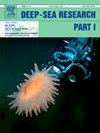Rock bottom: Colonization patterns of deep-sea Arctic and subarctic dropstones (200–1300 m)
IF 2.1
3区 地球科学
Q2 OCEANOGRAPHY
Deep-Sea Research Part I-Oceanographic Research Papers
Pub Date : 2025-01-25
DOI:10.1016/j.dsr.2025.104454
引用次数: 0
Abstract
Hard substrata of allochthonous origin, such as ice-rafted dropstones, can provide essential habitat for benthic communities in the polar and subpolar deep sea, acting as “islands” in otherwise finer-grained sedimentary environments. The present study explored the diversity and distribution patterns of morphospecies (msp/mspp) present on dropstones collected at depths of ∼200–500 m in the Labrador Sea (LAB) and ∼700–1300 m in Baffin Bay (BAF), respectively spanning subarctic and Arctic regions of eastern Canada. Specifically, the zonation, intra- and interspecific interactions, and succession of all colonizers were examined. Based on in-situ images, dropstones exhibited ∼94% greater epibenthic megafaunal richness than similar surfaces of the substratum immediately surrounding them. Analysis of three dropstones collected from each of six sites documented a total of 101 sessile and motile taxa spanning 10 phyla. Across sites, bryozoans dominated at all depths and locations (27 mspp, plus 3 dead) followed by poriferans (27 mspp), 19 cnidarians, eight arthropods, eight annelids, five chordates (tunicates), three echinoderms, three molluscs, and one foraminifer. There were 19 mspp that spanned both LAB and BAF, with greater overall richness in the subarctic region (62 vs 26 mspp). A total of 64 sessile mspp occurred above the stone-sediment interface (e.g., cnidarians and poriferans), whereas 22 mspp (mostly bryozoans) occurred at the stone-sediment interface; one morphospecies of polychaete occurred below. The most abundant morphospecies was an arborescent bryozoan, while two encrusting bryozoans covered the most surface area. Eight morphospecies occurred as just one individual or colony per stone, and 35 mspp appeared to maintain an exclusion zone between conspecifics (e.g., tube-dwelling annelids, hydrozoans, and anthozoans). Conversely, in 51 mspp conspecifics occurred abutting one another (e.g., bryozoans and poriferans). Allospecific exclusion zones appeared to occur in 27 mspp (e.g., bryozoans and annelids), whereas 59 allospecifics (e.g., poriferans, cnidarians, and chordates) occurred within touching distance. Secondary colonization (including cases of epibiosis) was observed in 83 mspp, documenting 204 unique pairings of hosts and colonizers. The number and diversity of morphospecies colonizing dropstones in the deep sea of the eastern Canadian Arctic and subarctic support the role of dropstones as oases that facilitate connectivity in an otherwise poorly diversified epibenthic environment.
海底:北极和亚北极深海坠石的殖民模式(200-1300米)
异域起源的硬基质,如浮冰坠石,可以为极地和亚极地深海的底栖生物群落提供必要的栖息地,在其他更细粒度的沉积环境中充当“岛屿”。本研究探讨了在拉布拉多海(Labrador Sea, LAB)和巴芬湾(Baffin Bay, BAF)分别跨越加拿大东部亚北极和北极地区的~ 200-500 m深度收集的dropstones上存在的形态物种(msp/mspp)的多样性和分布模式。具体地说,研究了所有殖民者的分区、种内和种间相互作用和演替。根据原位图像,水滴石的底栖巨型动物丰富度比它们周围类似的基质表面高出约94%。对从6个地点采集的3个滴落石的分析记录了101个无根和活动的分类群,跨越10门。苔藓虫在所有深度和位置均占主导地位(27 mspp,死亡3只),其次是孔虫(27 mspp)、针胞动物19只、节肢动物8只、环节动物8只、脊索动物(被囊动物)5只、棘皮动物3只、软体动物3只和有孔虫1只。有19个mspp跨越了LAB和BAF,亚北极地区的总体丰富度更高(62 mspp vs 26 mspp)。石-沉积物界面上方有64个无根mspp(如刺胞动物和多孔动物),而22个mspp(主要是苔藓虫)发生在石-沉积物界面;多毛类的一种形态出现在下面。最丰富的形态种是树状苔藓虫,而两种结壳苔藓虫覆盖了最大的表面积。有8种形态种每块石头只出现一个个体或群体,35种形态种似乎在同种动物(如管栖环节动物、水螅动物和花甲动物)之间保持着一个隔离带。相反,在51 mspp中,同种生物彼此相邻(例如苔藓虫和多孔虫)。同种异体隔离区出现在27个mspp中(如苔藓虫和环节动物),而59个同种异体(如多孔动物、刺胞动物和脊索动物)出现在接触距离内。在83个mspp中观察到继发性定植(包括表皮生长),记录了204对独特的寄主和定植者配对。定居在加拿大东部北极和亚北极深海的坠石形态物种的数量和多样性支持了坠石作为绿洲的作用,促进了多样性不足的底栖环境的连通性。
本文章由计算机程序翻译,如有差异,请以英文原文为准。
求助全文
约1分钟内获得全文
求助全文
来源期刊
CiteScore
4.60
自引率
4.20%
发文量
144
审稿时长
18.3 weeks
期刊介绍:
Deep-Sea Research Part I: Oceanographic Research Papers is devoted to the publication of the results of original scientific research, including theoretical work of evident oceanographic applicability; and the solution of instrumental or methodological problems with evidence of successful use. The journal is distinguished by its interdisciplinary nature and its breadth, covering the geological, physical, chemical and biological aspects of the ocean and its boundaries with the sea floor and the atmosphere. In addition to regular "Research Papers" and "Instruments and Methods" papers, briefer communications may be published as "Notes". Supplemental matter, such as extensive data tables or graphs and multimedia content, may be published as electronic appendices.

 求助内容:
求助内容: 应助结果提醒方式:
应助结果提醒方式:


